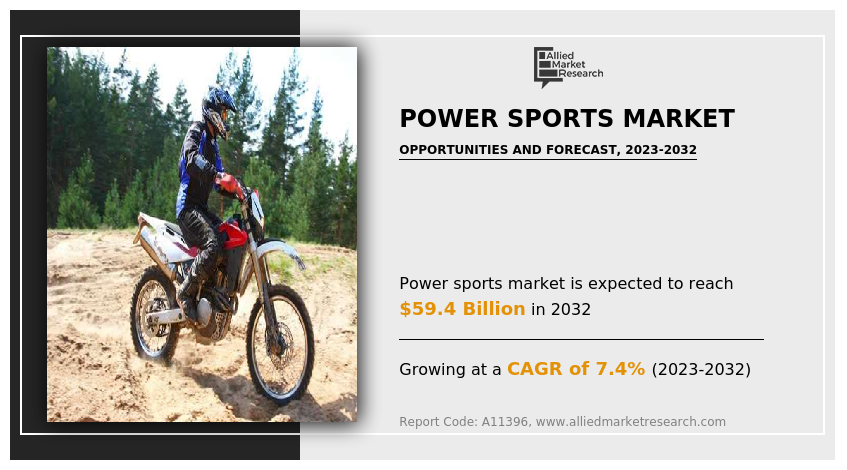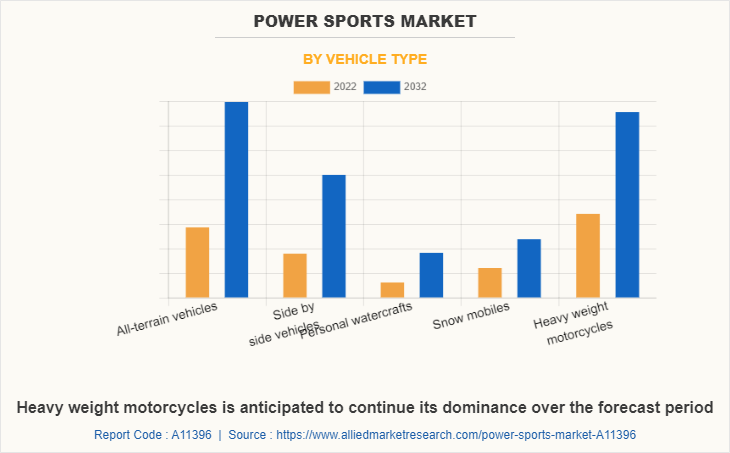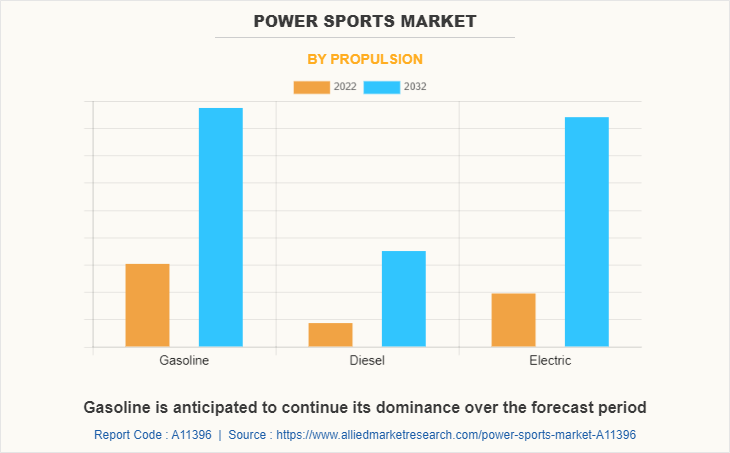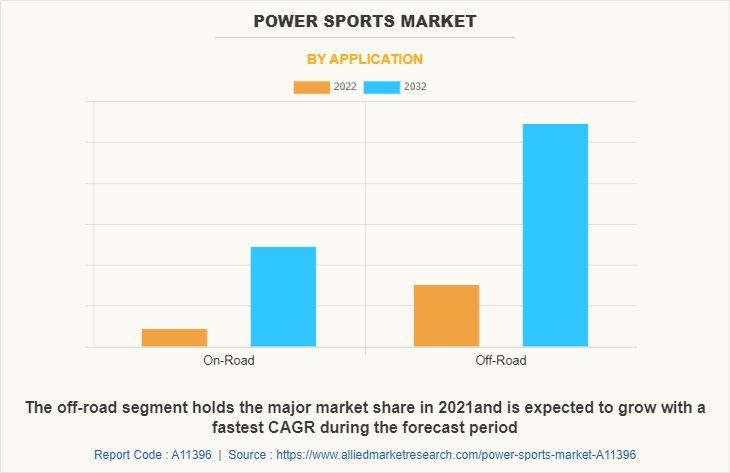Power Sports Market Research, 2032
The global power sports market size was valued at $29.6 billion in 2022, and is projected to reach $59.4 billion by 2032, growing at a CAGR of 7.4% from 2023 to 2032. Power sports activities refer to a category of recreational or competitive activities that involve the use of motorized vehicles or equipment designed for high-performance and exhilarating experiences. These activities often require a certain level of skill, physical exertion, and a passion for speed.
The power sports category encompasses activities like off-roading, motocross, all-terrain vehicle (ATV) racing, and side-by-side (UTV) racing. Off-road automobiles are designed to traverse difficult terrains such as dirt tracks, trails, mud, sand, or rocky landscapes. Motorcycling involves riding motorcycles, whether for leisurely cruising, sport riding, or competitive racing. Motorcycles come in different styles, including sports bikes, cruisers, dirt bikes, and traveling bikes. Power sports refer to recreational or competitive activities involving the use of motorized vehicles or equipment designed for thrilling experiences in various terrains, including off-road, water, or snow.

Increasing consumer interest in outdoor recreational activities and adventures has been a major growth driver for the power sports market. More individuals are seeking thrilling experiences and outdoor recreation, which has boosted the demand for power sports vehicles. Moreover, the power sports vehicles such as all-terrain vehicles (ATVs), personal watercraft, snowmobiles, and bikes provide exhilarating experiences to riders. The thrill and excitement associated with these activities have attracted a large number of consumers who are seeking adventurous and adrenaline-pumping experiences. Power sports activities vehicles provide an avenue for people to explore and revel in outdoor spaces, whether it is using ATVs through trails, jet skiing on lakes, or snowmobiling in winter landscapes. Furthermore, power sports activity vehicles have become popular among individuals who view them as a lifestyle preference or a form of entertainment activity. Owning and riding these vehicles is seen as a way to embrace an active and adventurous lifestyle. In addition, participation in power sports activities can provide opportunities for socialization and community engagement with like-minded enthusiasts. The power sports industry has experienced significant growth, with more individuals seeking thrilling experiences and outdoor recreation. The demand for electric power sports industry is expected to continue rising as consumer interest in outdoor activities and adventures persists.
Power sports vehicles can be expensive, especially those with advanced features and technologies. The initial high cost can limit the consumers with sufficient disposable income. Economic downturns or recessions can have a significant effect on the power sports market as consumers might also cut back on discretionary spending. Moreover, the high price tags of power sports vehicles, such as motorcycles, ATVs, or personal watercraft, can make them unaffordable for many potential buyers. The cost includes not only the initial buy but also maintenance, insurance, fuel, and other associated expenses. These factors can further limit the potential consumer base due to affordability constraints and hamper the market revenue growth during the forecast period.
Manufacturers are incorporating features like improved engine performance, enhanced safety features, advanced suspension systems, and integration of smart technologies. These innovations attract consumers looking for cutting-edge products, giving companies a competitive edge. Moreover, continuous improvements in power sports technologies, such as enhanced engine performance, advanced suspension systems, and smart technology integration, attract consumers who seek high-performance and feature-rich products. Furthermore, technological advancements enable manufacturers to differentiate their offerings from competitors. Enhanced safety features, such as advanced braking systems, traction control, and stability control, can provide added value to consumers concerned about safety. Integration of smart technologies, such as GPS navigation, wireless connectivity, and digital displays, can enhance the overall user experience and set a product apart from the competition. Technological advancements can drive the development of more eco-friendly power sports vehicles, such as electric or hybrid models. Manufacturers investing in these technologies can tap into the developing market of environmentally conscious consumers and position themselves as leaders in sustainable power sports solutions.
The key players profiled in this power sports market report include Polaris Inc., Arctic Cat Inc., Bombardier Recreational Products Inc., Suzuki Motor Corporation, Yamaha Motor Co., Ltd., Kawasaki Motors, Ltd., RumbleOn INC., Honda Motor Co., Ltd., Harley Davidson, Inc., and Kubota Corporation. For instance, in March 2021, Polaris, an automotive manufacturing company, unveiled its lineup of snowmobiles for 2022, which featured 22 new models built on the rider-first Matryx platform. The combustion stability provided by the SmartBoost technology generates 10% more power at sea level and 50% more power at 10,000 feet above the 850 Patriot.
The power sports market is segmented on the basis of vehicle type, application, propulsion, and region. By vehicle type, the market is divided into all-terrain vehicles (ATV), side by side vehicles, personal watercrafts, snowmobiles, and heavyweight motorcycles. By application, the market is classified into on-road and off-road. By propulsion, the market is classified into gasoline, diesel, and electric. By region, the market is analyzed across North America, Europe, Asia-Pacific, and LAMEA.The power sports market is segmented into Vehicle type, Propulsion and Application.

By vehicle type, the all-terrain vehicles (ATV) sub-segment dominated the market in 2022. ATVs are recognized for their versatility and ability to traverse various terrains, such as mud, snow, sand, and rugged trails. This versatility makes them appealing to a wide range of users, including recreational riders, outdoor enthusiasts, farmers, ranchers, and industrial workers. Moreover, ATVs are popular amongst outdoor enthusiasts for recreational purposes. They offer an exhilarating riding experience and can be used for activities like trail riding, racing, hunting, and exploring off-road areas. The thrill and adventure associated with ATV riding attract many individuals and families looking for outdoor recreational activities. ATVs are widely used for utility purposes, especially in rural and agricultural settings. Farmers, ranchers, and landowners utilize ATVs for tasks such as hauling equipment, transporting supplies, herding livestock, and maintaining large properties. The ability to carry heavy loads and navigate through challenging terrains makes ATVs highly valuable for utility applications. The rise of adventure tourism and the demand for unique experiences have boosted the growth of the ATV segment. These are predicted to be the major factors affecting the power sports market size during the forecast period.

By propulsion, the gasoline sub-segment dominated the global power sports industry share in 2022. Gasoline-powered vehicles, such as motorcycles, ATVs, and personal watercraft, offer high-performance capabilities and greater power compared to their electric counterparts. These vehicles are popular among enthusiasts who seek thrilling and fast-paced experiences in off-road or water-based environments. Gasoline-powered vehicles benefit from an extensive infrastructure that supports their usage. Gas stations are widely available, making it convenient for users to refuel their vehicles during their adventures. This well-established infrastructure helps maintain the popularity of gasoline-powered power sports vehicles. Gasoline-powered vehicles typically have longer range and endurance compared to electric vehicles. This aspect is particularly important in off-road environments where access to charging stations may be limited. Power sports enthusiasts, such as those engaged in long-distance trail riding or extended water-based activities, often prefer gasoline-powered vehicles for their extended range. Gasoline-powered power sports vehicles can often be more affordable upfront compared to their electric counterparts. In addition, the cost of maintenance and repairs for gasoline-powered vehicles is often lower. This affordability can make them an attractive option for individuals who wish to have power sports market data incurring significant expenses.

By application, the off-road sub-segment dominated the global power sports industry share in 2022. Off-roading provides individuals with a sense of adventure, thrill, and excitement. Many enthusiasts are drawn to the off-road segment as it allows them to explore challenging terrains, experience outdoor adventures, and enjoy recreational activities such as trail riding, rock crawling, and dune bashing. Moreover, the off-road segment aligns with the outdoor lifestyle and appeals to individuals who enjoy spending time in nature. Off-road vehicles, such as all-terrain vehicles (ATVs), utility task vehicles (UTVs), and dirt bikes, enable users to access remote locations, go camping, hunting, fishing, or simply enjoy off-road trails and tracks. Off-road racing and competitive events like motocross, rallycross, and desert racing have gained significant popularity in recent years. Motorsport enthusiasts and professional racers are attracted to the off-road segment to showcase their skills, compete against others, and experience the adrenaline rush associated with high-speed off-road racing. Off-road destinations and adventure tourism have become increasingly popular in the last few years. Many travelers seek unique experiences and off-road tours, which offer them the opportunity to explore diverse landscapes, scenic trails, and challenging terrains. Off-road vehicles provide the means to navigate these regions, attracting tourists and contributing to the growth of the power sports market.

By region, North America dominated the global market in 2022. Individuals in the U.S. and Canada have a high level of disposable income which enables them to afford recreational activities and invest in power sports vehicles such as motorcycles, ATVs, personal watercraft, and snowmobiles. Power sports vehicles offer exciting and adrenaline-pumping experiences, attracting enthusiasts who enjoy activities like off-roading, water sports, and recreational riding. Moreover, North America is a popular destination for tourism and leisure activities, including power sports. Many regions in the US power sports market and Canada have extensive trail networks, water bodies, and scenic landscapes that attract tourists and provide opportunities for power sports activities. The power sports industry continuously invests in R&D to introduce innovative products and improve vehicle performance. Technological advancements such as enhanced safety features, improved fuel efficiency, and electric powertrain options have expanded the fascination of power sports vehicles in the region.
Impact of COVID-19 on the Global Power Sports Industry
- The power sports industry experienced disruptions in production and supply chains due to lockdown measures and restrictions on non-essential businesses. Many manufacturing facilities had to temporarily shut down or operate at reduced capacity, leading to delays in production and delivery of power sports vehicles.
- The economic uncertainty and restrictions imposed during the pandemic resulted in reduced consumer demand for power sports vehicles. With travel restrictions and social distancing measures in place, people were less inclined to participate in recreational activities that required the use of power sports vehicles. This led to a decline in sales and revenue for manufacturers and dealers.
- Power sports events, such as races, rallies, and exhibitions, were either canceled or postponed due to strict restrictions during the pandemic. These events are essential for promoting power sports vehicles and generating excitement among enthusiasts. The absence of such events had a negative impact on the visibility and promotion of power sports products.
- Power sports vehicles are often rented by tourists and used for recreational purposes in popular destinations. The travel restrictions and reduced tourism during the pandemic had a significant impact on the rental and tourism industry, subsequently affecting the demand for power sports vehicles in these areas.
Key Benefits For Stakeholders
- This report provides a quantitative analysis of the market segments, current trends, estimations, and dynamics of the power sports market analysis from 2022 to 2032 to identify the prevailing power sports market opportunities.
- The market research is offered along with information related to key drivers, restraints, and opportunities.
- Porter's five forces analysis highlights the potency of buyers and suppliers to enable stakeholders make profit-oriented business decisions and strengthen their supplier-buyer network.
- In-depth analysis of the power sports market segmentation assists to determine the prevailing power sports industry statistics opportunities.
- Major countries in each region are mapped according to their revenue contribution to the global power sports industry outlookmarket.
- Market player positioning facilitates benchmarking and provides a clear understanding of the present position of the market players.
- The report includes the analysis of the regional as well as global power sports market trends, key players, market segments, application areas, and market growth strategies.
Power Sports Market Report Highlights
| Aspects | Details |
| Market Size By 2032 | USD 59.4 billion |
| Growth Rate | CAGR of 7.4% |
| Forecast period | 2022 - 2032 |
| Report Pages | 300 |
| By Vehicle type |
|
| By Propulsion |
|
| By Application |
|
| By Region |
|
| Key Market Players | Honda Motor Co., Ltd., Bombardier Recreational Products Inc., Harley Davidson, Inc., RumbleOn INC., Kawasaki Motors, Ltd., Suzuki Motor Corporation, Arctic Cat Inc., Polaris Inc., Yamaha Motor Co., Ltd., KUBOTA Corporation. |
The growing disposable income is one of the major factors boosting the demand for power sports. As people have more disposable income, they are more likely to spend on recreational activities, including power sports vehicles such as motorcycles, all-terrain vehicles, snowmobiles, and personal watercraft, which is estimated to generate excellent opportunities in the power sports market.
The major growth strategies adopted by the power sports market players are investment and agreement.
Asia-Pacific will provide more business opportunities for the global power sports market in the future.
Polaris Inc., Arctic Cat Inc., Bombardier Recreational Products Inc., Suzuki Motor Corporation, Yamaha Motor Co., Ltd., Kawasaki Motors, Ltd., RumbleOn INC., Honda Motor Co., Ltd., Harley Davidson, Inc., and Kubota Corporation are the major players in the power sports market.
The gasoline sub-segment of propulsion acquired the maximum share of the global power sports market in 2022.
Motorsports enthusiasts and off-road enthusiasts are the major customers in the global power sports market.
The report provides an extensive qualitative and quantitative analysis of the current trends and future estimations of the global power sports market from 2022 to 2032 to determine the prevailing opportunities.
The market for power sports is influenced by the increasing use of off-road vehicles, such as All-Terrain Vehicles (ATVs), Utility Task Vehicles (UTVs), and dirt bikes for exploring challenging terrains, including forests, deserts, and mountains. Off-roading provides enthusiasts with an exhilarating experience, allowing them to navigate through rough trails and overcome obstacles which is estimated to drive the adoption of power sports.
There is a growing demand for eco-friendly power sports options owing to increasing concerns about the environment and sustainability. Manufacturers and retailers can capitalize on this opportunity by developing electric or hybrid power sports vehicles and promoting their environmental benefits. These trends are anticipated to boost the power sports market in the upcoming years.
Loading Table Of Content...
Loading Research Methodology...



